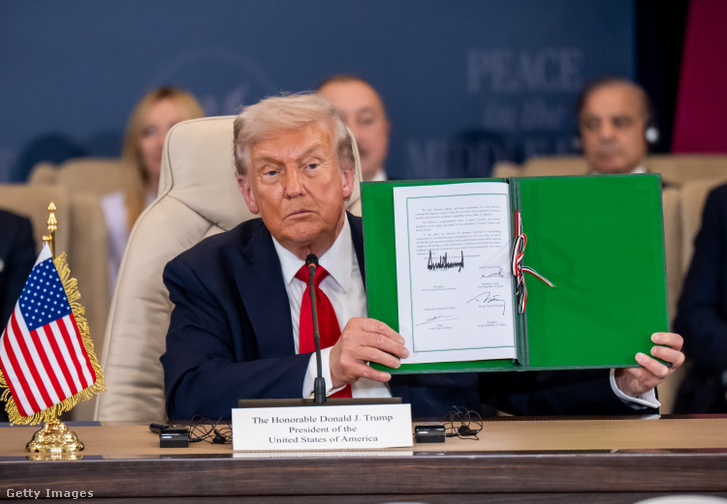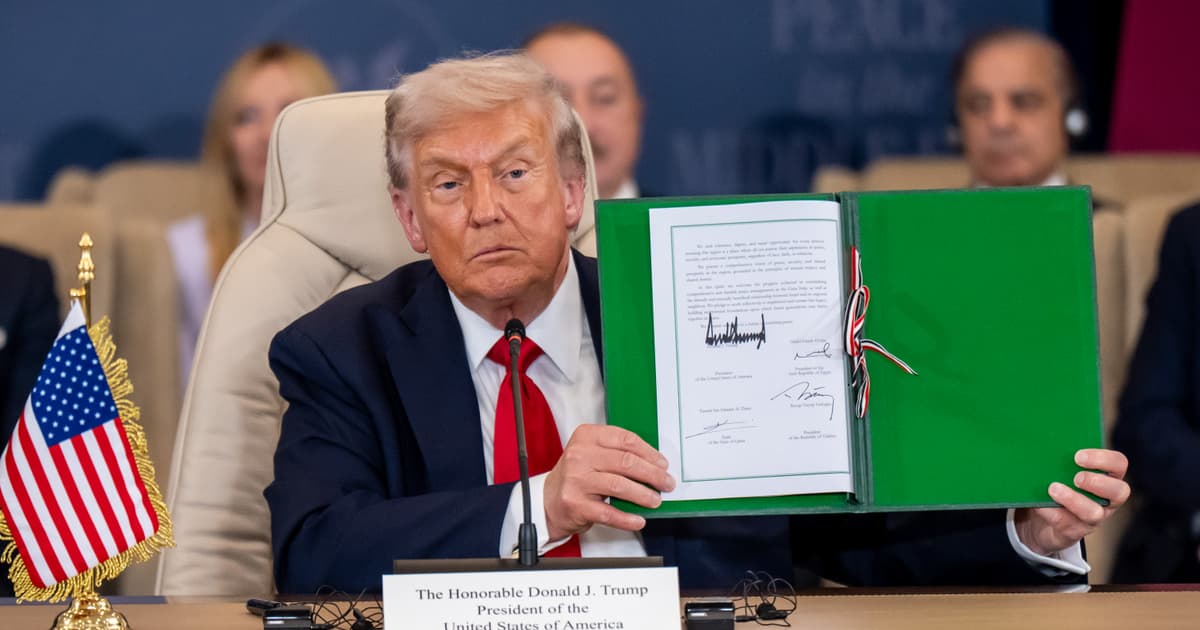The Gaza peace plan, announced by US President Donald Trump and Israeli Prime Minister Benjamin Netanyahu at the end of September and signed by the leaders of the United States, Egypt, Turkey and Qatar on October 13, can be seen as a major diplomatic breakthrough. Thanks to the efforts of the mediators, Hamas also accepted the agreement, László Sárkány, a researcher at the Eurasia Center, told Index.
The participation of the leaders of the twenty countries indicated the international weight and diplomatic significance of the meeting. The researcher highlighted: the fact that the Prime Minister of Hungary was not only invited to the event, but was personally invited by President Donald Trump himself and publicly praised him, clearly shows that our country has much greater geopolitical influence compared to its size.
This is – in László Sárkány's opinion – the result of the foreign policy activity of the current government and the Prime Minister, regardless of how its domestic and international critics evaluate it.

This is Index's geopolitical column, World Game, where we provide weekly analyses of the most important developments in international politics and conflicts. Analysts help us understand global processes, great power interests, and their impact on world politics.
Testing “eternal peace”
The Eurasia Center researcher explained that the Middle East peace plan is not only intended to end the two years of fighting, destruction and suffering in Gaza, but also aims to comprehensively resolve the Israeli-Palestinian conflict. The agreement thus holds the promise of long-term stability in the Middle East, even “eternal peace” in Donald Trump’s words.
While President Trump's merit and weight in this is undeniable, the very meaning of the word Jerusalem – the city of peace – reminds us that perfect, complete peace can be a reality in the heavenly Jerusalem. In the meantime, however, there is still work to be done here on earth: the actions that follow the great words will show their true weight
– said László Sárkány.
According to the researcher, the parties involved still have to overcome many obstacles before the peace plan can be gradually implemented, but the most important step has already been taken: it is a joyous development that all surviving Israeli prisoners have been released and their loved ones can embrace them safely at home.
The coincidence between the presence of twenty state leaders and the number of twenty surviving hostages is hardly a coincidence
– László Sárkány drew attention.
The first measures of the signed peace plan allow for rapid and immediate implementation and provide concrete means to meet priorities: an immediate prisoner exchange, a cessation of fighting, and the entry of humanitarian aid into Gaza in greater quantities and in sufficient proportions. However, the further provisions regarding the new governance of Gaza, the disarmament of Hamas, the end of the war, and the withdrawal of the Israeli army are much less clear, the researcher pointed out.
For this reason, it cannot be ruled out that any of the parties involved could torpedo the process. After the initial optimism, the main question is whether the roadmap can serve as a workable framework for the implementation of the next phases. On the positive side, it should be noted that the first steps in implementing the plan have so far been crowned with success
– added László Sárkány.
Trump and Netanyahu rewrote the plan
The Eurasia Center researcher highlighted that regarding the second phase, the plan – even before the subsequent amendment – stated that Israel would not occupy or annex Gaza, would gradually withdraw from the territory, allow humanitarian aid to enter and allow international organizations to distribute it without interference. According to the document, the Gazan population will not be obliged to leave the country: it is their decision to stay or leave, and if they leave, it is up to them to decide when to return. The plan also states that “we encourage the Palestinians to stay and help build a better Gaza”, and also recognizes the Palestinians’ aspiration to establish their own state.
This would be a twist that only occurs in the tales of One Thousand and One Nights. It is not ruled out in the harsh reality, but the point is the condition and the conditional mood
– stated László Sárkány.
He pointed out that the other side of the promise – the other side of the coin – is the conditionality, the threat and the fulfillment of the promise, which applies to all parties involved. The Israeli side addressed Hamas with an ultimatum and a threat, which is one of the many uncertain factors with which one cannot “calculate with certainty”. Failure to fully disarm could be a casus belli for Israel, which could lead to the launch of a final offensive. But even if this obstacle were to be overcome peacefully, the road to peace could still easily become bumpy.
After the original plan was supported by many Arab and Muslim leaders and shared with Hamas, according to Axios, the American and Israeli sides subsequently unilaterally modified it.
This became clear after Netanyahu's meeting with Trump, when the Israeli prime minister announced in a video message that he had managed to significantly change the agreement and that the Israeli army had no intention of leaving Gaza in the foreseeable future or allowing the establishment of a Palestinian state. This, in turn, could justify the continued presence of Hamas, which could justify the stay of Israeli forces and even a new offensive. Vicious circle
- said the researcher.
A fragile peace that anyone can break
According to László Sárkány, it is important to realize that the Trump plan is not an agreement, but the creation of a framework for a future agreement – or agreements. In other words, it is still just a “plan”. The initial phase of this included the release of Hamas hostages, which was a very specific commitment to be fulfilled within 72 hours, followed by the release of Palestinian prisoners.
“However, the remaining provisions of the plan are open to multiple interpretations,” the researcher pointed out, adding that several significant shortcomings make implementation difficult:
- It is unclear who will select the technocratic Palestinian Committee that would run Gaza’s day-to-day affairs. All that is specified is that members cannot be members of Hamas, but the criteria and mechanism for selection and appointment are unclear.
- It is not specified what is expected of the Palestinian Authority, or who will decide whether it has truly reformed enough to meet the requirements. This is particularly important because the gradual withdrawal of Israeli forces from Gaza is explicitly linked to the Palestinian Authority’s reform and ability to govern. A possible declaration of incompetence could be enough to allow the Israeli military to continue to maintain a presence in the zone.
- The plan also does not provide for a way to resolve conflicts between the parties. It is unclear whether disputes would be resolved through arbitration, mediation, the International Court of Justice, or some higher decision-making forum.
- While the plan requires regional parties to provide guarantees that Hamas will comply with its obligations, it is unclear what those guarantees are. It also does not specify what consequences Israel would face if it did not fulfill its own commitments. This issue is particularly sensitive because Netanyahu has said that the Israeli military has no plans to withdraw from most of Gaza in the foreseeable future.
The Eurasia Center researcher also pointed out that the initial ceasefire agreement between Hamas and Israel, reached on January 15 this year, contained detailed provisions for three phases, but Israel terminated it after the first phase. After Hamas handed over most of the hostages it held, Israel resumed its bombing and blockade of Gaza.
According to László Sárkány, we can trust that this agreement, this peace plan, will not suffer a similar fate. With the strengthening of the mechanisms and political will necessary for its implementation, it may turn out differently this time, but – as he put it – the concerns are by no means unfounded.

